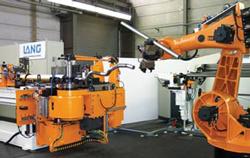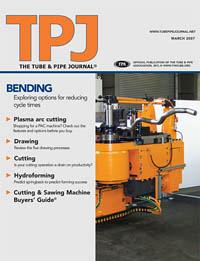- FMA
- The Fabricator
- FABTECH
- Canadian Metalworking
Categories
- Additive Manufacturing
- Aluminum Welding
- Arc Welding
- Assembly and Joining
- Automation and Robotics
- Bending and Forming
- Consumables
- Cutting and Weld Prep
- Electric Vehicles
- En Español
- Finishing
- Hydroforming
- Laser Cutting
- Laser Welding
- Machining
- Manufacturing Software
- Materials Handling
- Metals/Materials
- Oxyfuel Cutting
- Plasma Cutting
- Power Tools
- Punching and Other Holemaking
- Roll Forming
- Safety
- Sawing
- Shearing
- Shop Management
- Testing and Measuring
- Tube and Pipe Fabrication
- Tube and Pipe Production
- Waterjet Cutting
Industry Directory
Webcasts
Podcasts
FAB 40
Advertise
Subscribe
Account Login
Search
Reducing tube bending cycle times
Automating benders and peripheral equipment
- By Sabine Neff
- March 13, 2007
- Article
- Tube and Pipe Fabrication
Two trends—unrelenting cost pressures and the inclination to send manufacturing jobs to low-cost countries—have left many fabricators feeling that they are caught in a trap with no way out. While the pressure to reduce costs will never subside, and the low manufacturing costs in many countries will continue to lure manufacturing away, technological developments—mainly in automation—can help you maintain, and perhaps even increase, market share.
Once the domain of high-volume manufacturers, automated equipment is embraced by a continuously growing number of small-volume manufacturers. Although automation cannot solve every manufacturing problem and prevent every manufacturing job from going overseas, it can be a big help.
It's not enough to automate a single piece of equipment. The time needed to manufacture a part from start to finish is only as fast as the slowest machine or process, so you must look at the entire process and implement automation accordingly.
First you must arm yourself with knowledge—What types of automated equipment are available? What do I need to reduce setup time? What do I need to reduce cycle time? What is suitable for my needs?—then shop around for the right equipment. Only then will you be ready to respond to the challenges that lie ahead.
Making Choices
Automation means different things to different manufacturers. The main differences are related to batch sizes. If you manufacture a small variety of parts in high-volume runs, you should focus mainly on cycle time, concentrating on equipment motion and part-handling cycles. If you make a large variety of parts in low-volume runs, you should focus on equipment setup and tooling changeover times.
Outfitting a Production Cell. In a production cell, optimizing efficiency often requires a three-axis loader and a robot. The loader takes a raw tube from a storage rack and loads it into the first machine in the cell. The robot advances the tube from one station to the next. One important guideline is that the cell must process the part completely. This prevents additional handling and long conveying times.
An alternative is a robot with two sets of grippers. One set of grippers removes the in-process tube from the tube bender, while the other set loads the incoming tube into the bender.
Getting the most out of the bending cell requires automating every process. In the automotive industry, the necessary additional equipment often includes a tube magazine, weld seam detector, tube loader, extractor robot, a final processing station, saw, buffer, and transfer stations.
When the cell senses that it is nearly out of raw tube stock, the tube magazine traverses to the correct length of tube. A visual signal similar to a traffic light indicates to the stacker truck driver which type of tube he must load into the magazine. When one tube size is changed to another size, another signal indicates that the operator must configure the weld seam detector for the new tube size.
The bending tools for tubes with different diameters are mounted in a stack on the bending machine. When changing from one product to another, the operator merely retracts one set of tooling and advances another. Because the clamping jaws, slide rails, and wiper dies already are present, the operator does not need to change them.
Automating collet chuck and bending mandrel changeovers is not easy. Changing to a stepped collet chuck, one that accepts all tube diameters, is a way around collet chuck changeovers.
Mandrel changeover also resists automation. However, mandrel changeover can be simplified by storing the mandrels in a magazine and using an automated changeover process to select the next mandrel. Even so, such a system is limited to storing about three mandrels. Designing and producing a system that stores more mandrels is possible, but the cost of such a system is likely to outweigh the benefits.
With a partially automated system, changing the tube requires manually adjusting the magazine to the tube length, changing the mounts for the weld seam detector, and setting up a new bending tool and mandrel. The fully automated system described here requires just two steps: changing the mandrel and selecting the new bending program.
Changing the bender's instructions is another process that can be automated. Some bending cells rely on the production control system to change the bender's instructions when changing from one part to another. The data goes from a CAD station to the production control system and then to the bender.
Bending Machines: Analyzing Motion and Consistency. Although hydraulic and electrohydraulic bending machines are prevalent throughout the tube bending industry, the use of electric machines continues to grow. A chief advantage of electric machines is their consistency. The volume of hydraulic fluid expands and contracts as the fluid's temperature changes, leading to inconsistent bending results. Electric bending machines do not have hydraulic fluid, so they don't have this problem.
With regard to traversing speeds, electric machines generally are faster than hydraulic machines. Simultaneous traversing among the various servo axes is faster than one servo axis traversing at a time. Simultaneous traversing is standard on electric machines. For a hydraulic bender that lacks this capability, installing a larger pump or an additional pump might be necessary for simultaneous traversing.
If the clamping and positioning systems move to their new positions automatically after a tool change, this reduces the changeover time approximately 20 percent because no manual adjustments are required. This is a standard feature on electric bending machines. Electrohydraulic bending machines can be automated in this way. It requires a position-measuring system with proportional directional control valves. This is a benefit in rapid tool changing and helps to improve repeatability.
Changing Tooling. While it is impossible to eliminate manual tool changeovers, you have options for simplifying the process and reducing changeover times. Swivel brackets allow an operator to swing the various tools aside rather than remove them, which can cut changeover time from 15 minutes to three minutes. Likewise, quick-release collet chuck inserts allow an operator to release the chuck jaws by turning a wrench. The slide rails are not secured with screws, but simply are attached to T-groove guides.
Monitoring Quality. Quality control is another aspect of bending that is amenable to automation. The bending parameters can be sent to a printer or computer that records, stores, and evaluates all the data required for quality management. This data can be compared with a test record generated by a coordinate measuring machine.
How Much Skill Is Necessary For Running a Sophisticated Bending Cell?
Some fabricators fear that a greater degree of automation means the process is more prone to errors or that it requires more highly skilled operators to run. This isn't necessarily true. Modern control systems allow semiskilled employees to operate sophisticated systems. A graphic representation of the bending cell with a display of each bending component helps to make running a bending cell intuitive and troubleshooting straightforward.
Controllers usually have a variety of access levels. Locking less-skilled operators out of higher-level control functions can prevent an inexperienced employee from making critical system changes.
About the Author
Sabine Neff
12055 Universal Drive
Taylor, MI 48180
734-946-0417
About the Publication
subscribe now

The Tube and Pipe Journal became the first magazine dedicated to serving the metal tube and pipe industry in 1990. Today, it remains the only North American publication devoted to this industry, and it has become the most trusted source of information for tube and pipe professionals.
start your free subscription- Stay connected from anywhere

Easily access valuable industry resources now with full access to the digital edition of The Fabricator.

Easily access valuable industry resources now with full access to the digital edition of The Welder.

Easily access valuable industry resources now with full access to the digital edition of The Tube and Pipe Journal.
- Podcasting
- Podcast:
- The Fabricator Podcast
- Published:
- 04/16/2024
- Running Time:
- 63:29
In this episode of The Fabricator Podcast, Caleb Chamberlain, co-founder and CEO of OSH Cut, discusses his company’s...
- Trending Articles
Team Industries names director of advanced technology and manufacturing

Orbital tube welding webinar to be held April 23

Chain hoist offers 60-ft. remote control range

Push-feeding saw station cuts nonferrous metals

Corrosion-inhibiting coating can be peeled off after use

- Industry Events
16th Annual Safety Conference
- April 30 - May 1, 2024
- Elgin,
Pipe and Tube Conference
- May 21 - 22, 2024
- Omaha, NE
World-Class Roll Forming Workshop
- June 5 - 6, 2024
- Louisville, KY
Advanced Laser Application Workshop
- June 25 - 27, 2024
- Novi, MI



























